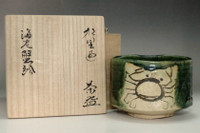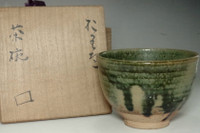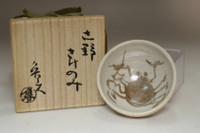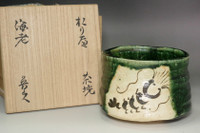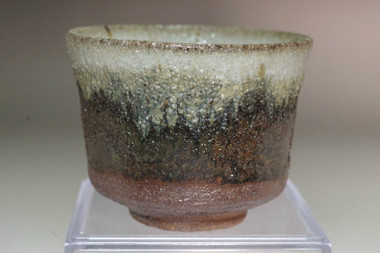 Loading... Please wait...
Loading... Please wait...Currency Displayed in
- Home
- SOLD ITEMS
- Kitaoji Rosanjin (1883-1959) Vintage Katatsu ware drinking cup #4076
Categories
Kitaoji Rosanjin (1883-1959) Vintage Katatsu ware drinking cup #4076 for sale
Product Description
Up for sale is this "Kitaoji Rosanjin (1883-1959) Vintage Katatsu ware drinking cup #4076" If you have any questions please contact us before buy it. No reserve.
- width: approx. 7.6cm (2 63⁄64in)
- height: approx. 5.8cm (2 9⁄32in)
- weight: 96g
Kitaoji Rosanjin (1883-1959)
Born in Kitaoji-cho, Kamigamo in Kyoto in 1883 (Meiji 16). Rosanjin's birth was a result of his mother having an affair and his father, disgusted by this, committed seppuku suicide 4 months before Rosanjin was born. He had a poverty-stricken childhood and was put into foster care as soon as he was born, being passed on to various loveless adoptive households where he suffered abuse until he settled into the Fukuda household at age 6. One day, while running an errand for the place where he worked, he saw the sign for a restaurant in town called 'Kamemasa' on a paper lantern. The sign bore a picture of a tortoise and some letters drawn in a single brush stroke without the brush leaving the paper, and it captivated him, heightening his curiosity towards art. The man who drew this sign was Takeuchi Seiho, the eldest son of Kamemasa's owner who would go onto become the leading figure of Kyoto's circle of artists that dominated the Teiten and Bunten exhibitions.
In 1905 (Meiji 38), he became a private apprentice to calligraphy artist Okamoto Katei (grandfather of Western style painter, Okamoto Taro) and lived with him for three years. There, he was given the name Fukuda Kaitsu, and over time he gradually began to receive more orders for his work than Katei. In 1907, he became independent from Katei as Fukuda Ōtei. His work prospered and he spent his earnings on calligraphy tools, antiques and dining away from home.
On December, 1910, he traveled to Korea and lived there for three years, working as a clerk in the Printing Bureau of Korea's Administrative Agency. After staying in Seoul for just under a year, he headed towards Shanghai, where he met Wu Changshuo, who was well-known for being the best in the generation in calligraphy, art and seal engraving.
He returned to Japan in the summer of 1912. Half a year later, he was invited as a dining guest by the wealthy Koji Toyokichi of Nagahama and was proposed a place where he can devote himself to calligraphy and seal engraving. Now under the name Fukuda Taikan, he left in Nagahama various masterpieces such as ceiling paintings in small pavilions, paintings on fusuma sliding doors and name engravings.
Then, his wish to become the dining guest for the Shibata household which was frequently visited by Takeuchi Seiho, who he admired and respected, was granted and he requested to make a name engraving for Seiho. Seiho took a liking to his engraving and introduced him to people under his tutelage such as Tsuchida Bakusen, making him increasingly well-known as he became acquainted with the masters of Japan's circle of artists.
In 1917 (Taisho 6), he became acquainted with Benrido's Nakamura Takeshiro and the two became good friends, afterwards running the antique store Taigado together. Taigado then began to serve regular visitors food made from high-quality ingredients served in the antique pottery in the store, and a diner made especially for those with a membership called 'Bishoku Kurabu' was started in 1921 (Taisho 10). Rosanjin himself stood in the kitchen and cooked, and also made the works of pottery used in serving the food. On March 20th, 1925 (Taisho 14), Rosanjin, along with Nakamura, borrowed 'Hoshigaoka-saryo restaurant' in Nagatacho, Tokyo and started a high-quality restaurant open only to those with a membership, with Nakamura as the owner and Rosajin as an advisor.
In 1927 (Showa 2), he invited people ranging from potter Miyanaga Tozan and Arakawa Toyozo to Yamasaki, Kamakura and established a place to research ceramics, Seikoyo, and began working on pottery in earnest.
After the war, he was economically impoverished and lived a life of adversity, but in 1946 (Showa 21), he opened a direct sales store for his own work in Ginza called 'Kadokadobibo' and gained positive feedback, even from Western people staying in Japan as well. In 1954 (Showa 29), under the invitation from the Rockefeller Foundation, he held exhibitions and lectures in various areas in the West, and also visited Pablo Picasso and Marc Chagall. In 1955 (Showa 30), his Oribe ware designated him as a Preserver of Important Intangible Cultural Properties (Living National Treasure), but he refused this title.
He passed away at Yokohama City University Hospital due to liver cirrhosis in 1959 (Showa 34).
shop policy
AppraisalWe are a very small team with limited resources and are unable to conduct scientific age verification or appraisals by the artist’s descendants. We evaluate items using specialized reference books, scholarly resources, and knowledge inherited from senior experts in the field. If a purchased item does not meet your expectations, please feel free to contact us. We sincerely value your opinion.
Cancellation and Return
We accept return only if you contact us within 30 days after you receive the items. Return-shipping costs are the buyer’s responsibility. If you ask a cancellation before shipping the package, we may ask a 20% restocking fee.
Shipping
+ Shipping to the USA, Europe, and Asia is free. For other areas, please contact us. Shipping is via EMS or DHL.
+ VAT is not included in the item price.
+ We will ship within 3 business days. Shipping time is usually around a week.
Insurance
We are not responsible for delays, returns, damage or loss due to customs or postal processing. EMS is insured (the amount on the label is the guaranteed amount). If you choose DHL, we recommend that you purchase additional insurance. Please note that if you choose the DHL drop service option, insurance will not be applied.
Taxes
Import duties, taxes and fees are not included in the item price. If your country requires customs duties, etc., it is your responsibility to pay them.
To customers buying tableware
Our products are mostly used. We sell them in the same condition they were purchased, please be sure to clean them thoroughly before actually using them.

